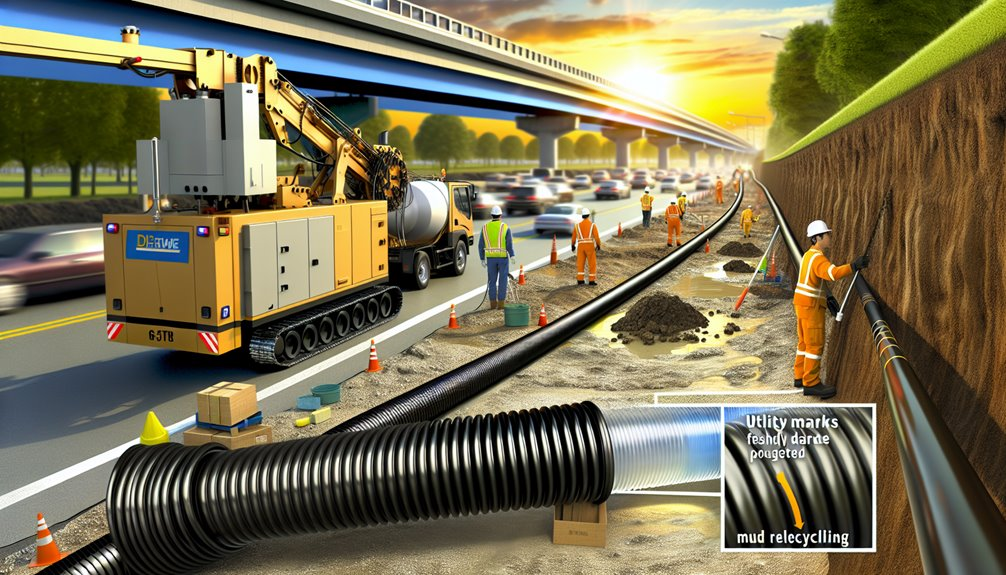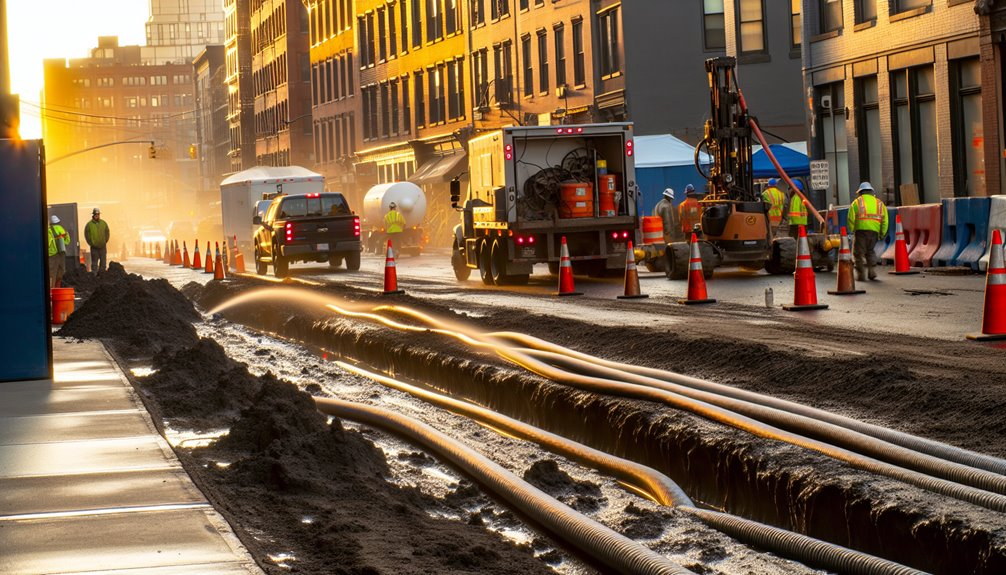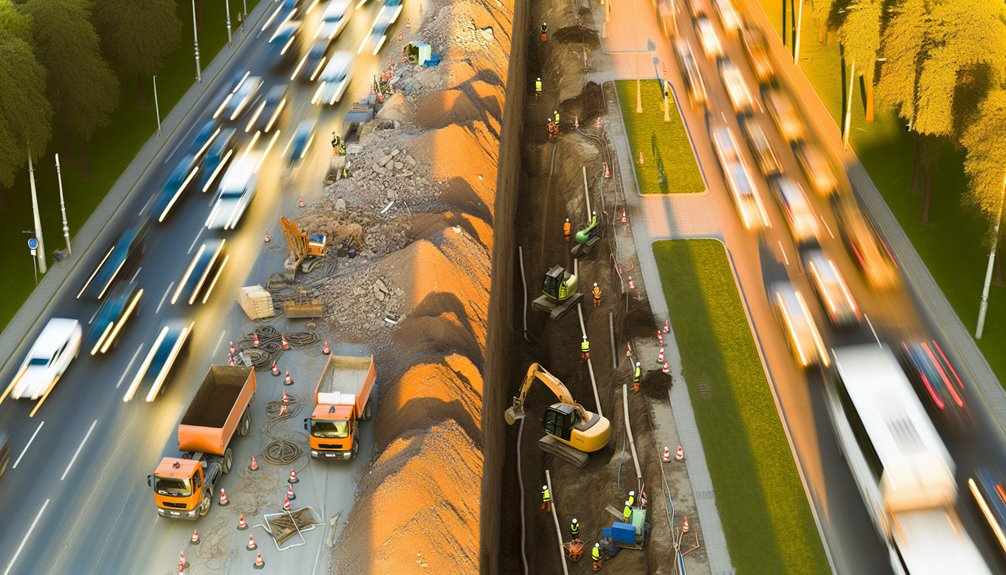If you need to install electrical conduits under active roadways, HDD lets you maintain traffic flow, protect pavement, and meet code with minimal restoration. You steer beneath utilities and geotechnical constraints, control drilling fluids, and document QA/QC for faster permit closeouts. It’s safer for crews outside live lanes and often faster than open-cut per DOT/MUTCD work-zone requirements. You’ll also cut noise, dust, and emissions—yet the real advantage shows up when you compare lifecycle costs…
Minimizing Traffic Disruption on Busy Corridors
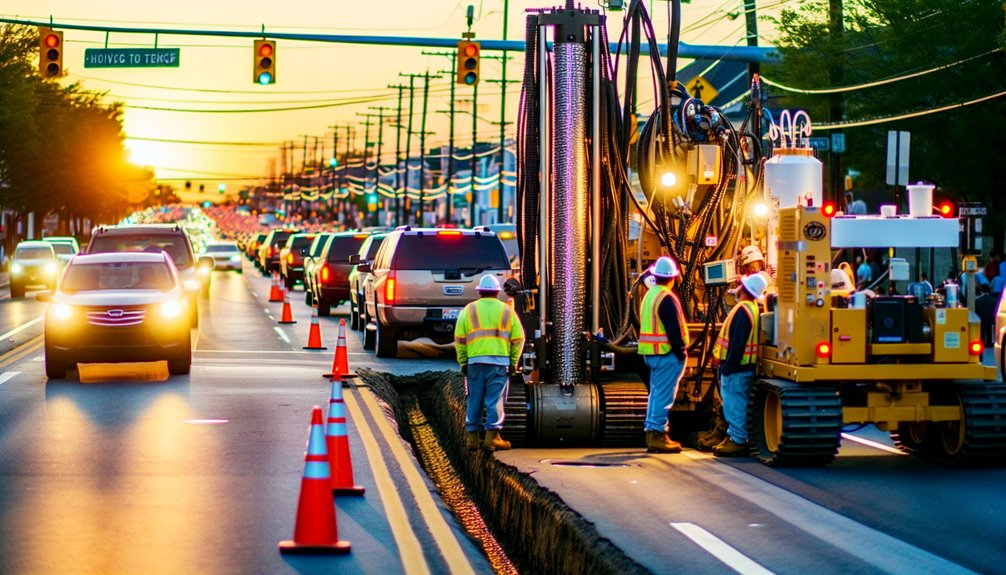
Often, you’ll minimize disruption by planning trenchless crossings with horizontal directional drilling (HDD) that keep lanes open while meeting permit conditions.
You’ll stage work per MUTCD Part 6 and local traffic-control ordinances, using short work windows, police details where required, and clear detour planning only when lane closures are unavoidable.
Coordinate utility locates per 811 and ASCE 38; verify drill path clearances to NEC 300.5 and local depth-of-cover standards.
Specify entry/exit pits outside traveled ways, maintain ADA-compliant pedestrian routes, and preserve bus operations.
Calibrate drilling fluids and returns control to prevent surface breakout into live lanes.
Schedule night or off-peak pulls, sequence deliveries, and use real-time communication with agencies.
Document compliance and as-built data to close permits confidently.
Preserving Pavement and Reducing Restoration Costs
While HDD inherently limits surface disturbance, you’ll further protect pavement and cut restoration costs by pushing all launch/exit pits to shoulders or parking bays, coring small-diameter openings instead of saw-cutting, and keeping haul routes off newly surfaced lifts. Specify core reinstatement per ASTM D4788 and ACI 546, and match asphalt mixes to agency standards (e.g., DOT Section 400) to sustain pavement longevity.
Use flowable fill per ASTM C940 under patched areas to prevent settlement. Require vacuum excavation for utility daylighting, not trenching, to preserve subbase integrity.
Coordinate with the authority having jurisdiction to align your restoration budgeting with permit conditions, including sawcut limits, patch thickness, and warranty terms. Document pre-construction conditions, density tests (AASHTO T 99/T 180), and infrared compaction checks to verify performance and reduce post-job claims.
Speed and Efficiency Compared to Open-Cut Trenching

Typically, HDD delivers faster installation than open-cut by eliminating long trench excavation, traffic control staging, and multi-lift pavement restoration. You shorten mobilization, bore, and pullback windows, keeping critical path durations tight. With pre-located utilities and an engineered bore plan, you meet NEC Article 300 burial clearances and maintain separation per ASCE/UESI 38 utility quality levels. HDD reduces lane closure time, so you finish crossings within night or weekend work windows.
You gain efficiency through disciplined crew coordination: staking, pilot bore, ream, and product pull occur in a continuous sequence, minimizing idle time. Preventive equipment maintenance—fluid systems, reamers, drill string—reduces unplanned stops and keeps penetration rates consistent. Standardized QA/QC (as-built tracking, inadvertent return monitoring) streamlines approvals, helping your team deliver predictable, repeatable schedules.
Enhanced Safety for Crews and the Public
Speed isn’t the only gain—you also cut risk to crews and the public. With HDD, you keep people and equipment out of live lanes, improving traffic safety and reducing work-zone conflicts. You minimize open excavations, slip-trips, and struck-by hazards. Follow OSHA 29 CFR 1926 Subpart P for limited pits, and use utility locates per 811 and ASCE 38 to avoid hits. Adopt ASTM F1962 for conduit design and verify pullback forces.
You’ll control the site with MUTCD-compliant traffic control plans, flagger certification, and clear detours. Build public awareness through advance notices, message boards, and coordination with first responders and adjacent businesses. Maintain positive bore tracking, drill fluid management, and strike alerts. Document JHAs, tailgate talks, and near-miss reports to reinforce a safety-first culture.
Environmental Advantages: Less Noise, Dust, and Disturbance
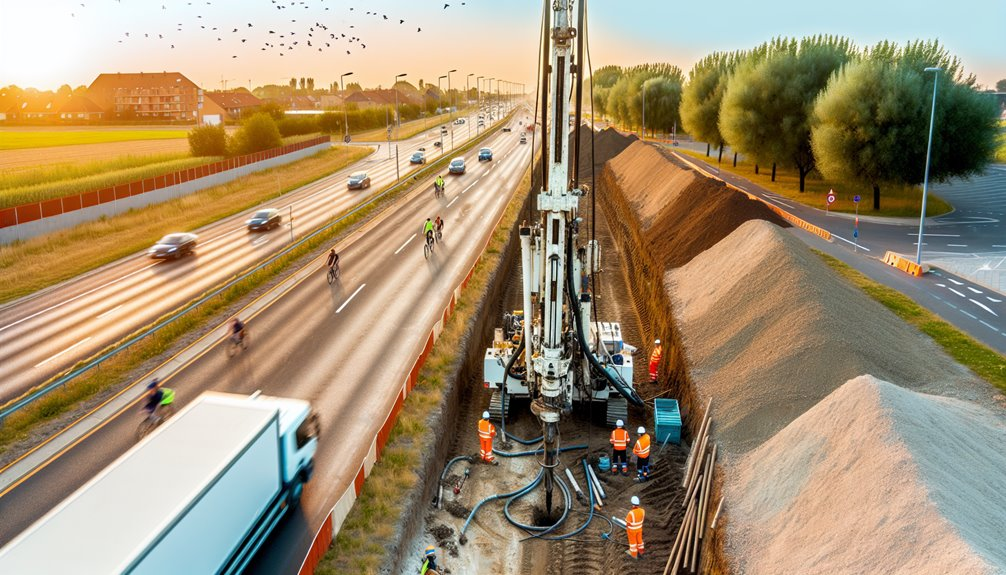
Because HDD installs conduits with small entry/exit pits instead of long open trenches, you sharply reduce noise, dust, vibration, and surface disruption. By limiting surface work zones, you shorten lane closures and protect air quality.
HDD rigs use lower emission equipment, meeting EPA Tier 4 standards and supporting municipal sustainability goals. Fluid management plans and BMPs for returns, as referenced in EPA NPDES and state erosion-control codes, keep sediments out of storm systems.
You also achieve reduced wildlife disruption by avoiding habitat fragmentation and nesting-season conflicts common with open cuts. Compaction and pavement fatigue are minimized per AASHTO and local restoration specs, lowering long-term maintenance impacts.
For communities, that means quieter streets, cleaner air, and faster restoration that welcomes everyone back.
Precision Steering With Modern Locating Technologies
Quiet, cleaner streets only matter if the bore stays on line and grade. You achieve that with modern locating systems that pair gyroscopic guidance and walkover antennas with drill head telemetry. Start each shot with precision calibration of the tracker, beacon, and pitch sensors per manufacturer specs and ASTM F1962 assumptions for bore path verification. Real time tracking lets you hold tolerances that meet NEC 300.5 depth requirements and DOT utility separation rules, adjusting clock-face corrections within a rod.
You’ll validate heading, pitch, and roll at every rod change, logging data to as-built records that satisfy permit conditions. Use interference checks, frequency hopping, and baseline tests to maintain signal integrity. With calibrated tools and disciplined procedures, your crew keeps the bore true—and the project compliant.
Navigating Complex Subsurface Conditions and Utilities

Although the bore plan is set, subsurface realities demand adaptive control. You ground your decisions in geotechnical mapping, recent potholing, and utility avoidance protocols. Verify depth, separation, and clearance per NEC Article 300.5, local DOT trenchless specs, and ASCE 38/CI/ASCE 75 quality levels.
Before pilot drilling, reconcile utility records with EM/RF locates and daylight critical crossings. When clay lenses, cobbles, or fractured rock appear, adjust mud weight, viscosity, and flow; switch to a reamer or bit suited to the formation. Maintain annular pressure to prevent inadvertent returns per EPA and municipal permits.
Hold line and grade with real‑time steering and strike alerts. Establish stop‑work thresholds, hand‑expose conflicts, and document as‑builts. Share findings with the team—everyone owns safe progress beneath the roadway.
Lifecycle Economics and Total Cost of Ownership
Field choices don’t end at safe steering—they shape cost curves for decades. With HDD, you cut lifecycle spend by minimizing pavement restoration, lane-closure costs, and service interruptions. ASTM F1962 and M55 guide pullback forces and DR selection, helping you right-size conduits and reduce premature failures. You’ll standardize bore logs, as-built accuracy, and grout specs so O&M stays predictable.
Total cost of ownership improves when you quantify trenchless advantages: fewer joints, lower infiltration, and faster reinstatement. Apply NPV and LCCA per FHWA guidance to compare HDD to open cut; include risk allowances for utility strikes, fluid loss, and downtime. HDD supports long term budgeting and replacement planning because you can stage parallel bores, select corrosion-resistant materials, and align inspection intervals with asset criticality and traffic impacts.
Regulatory Compliance and Permitting Benefits
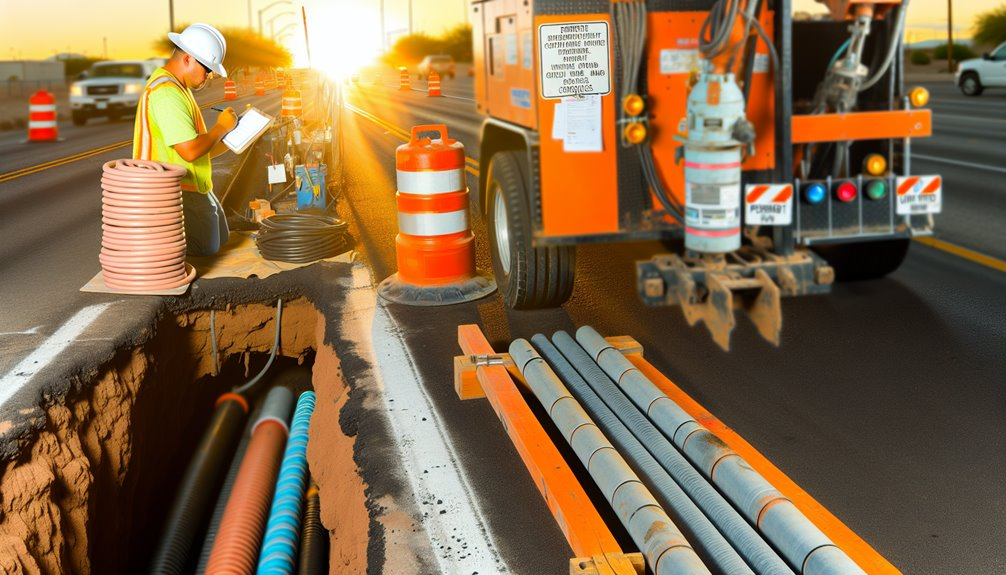
Because HDD stays below the roadway and minimizes disturbance, you’ll often navigate permitting faster and with fewer conditions. Agencies view trenchless crossings as lower-risk under typical right-of-way ordinances, utility accommodation policies, and erosion/sediment control codes. You benefit from permit streamlining when plans show depth-of-cover, bore path clearances to existing utilities, and frac-out containment per NPDES/SWPPP requirements. HDD also simplifies traffic-control approvals because you avoid full-lane cuts and long closures, easing inspection coordination across city, county, and DOT reviewers.
- Less surface impact, fewer surprises—your team stays aligned.
- Clear submittals, quicker approvals—you move together with confidence.
- Safer streets, happier neighbors—you belong in the solution.
Document as-built bore logs, fluid volumes, and pressure data to satisfy inspection closeouts and retain compliance records for renewal or future tie-ins.
Best Practices for Planning and Executing HDD Installations
While every crossing is site-specific, you’ll reduce risk and rework by front-loading design, subsurface data, and constructability checks. Perform route optimization with ASCE 38/CI utility quality levels and One-Call marks, then verify conflicts via potholing. Size conduits and bend radii per NEC Article 300 and manufacturer limits; confirm allowable pulling tension and sidewall pressure. Model bore profiles considering geotech logs, fluid loss zones, and settlement risk. Specify drilling fluids per ASTM F1962; plan containment, recycling, and frac-out response.
Standardize procedures, pre-job briefs, and contingency trees. Calibrate guidance systems and track tolerances. Stage spares, power, and vac capacity. Elevate crew training on mud rheology, steering, and strike avoidance. Document as-built with surveyed entry/exit, annular pressures, pullback loads, and test results.
Conclusion
As the owner of Boring Bros., I can tell you HDD is the smarter way to keep traffic moving, protect pavement, and cut restoration costs while meeting NEC Article 300 and NESC clearance requirements. We drill precisely around utilities per ASCE 38/CI/ASCE 75, manage fluids to ASTM/SPEL specs, and document QA/QC for swift permit closeouts. HDD reduces exposure hours per OSHA 1926, limits noise and dust, and accelerates schedules with fewer mobilizations. When we plan bore profiles, verify SUE, monitor returns, and execute pullbacks to spec, the result is safer, faster, lower‑risk conduit installs. If you want to learn more, please visit boringbro.com or give us a call at (954) 639-6167 — we’d love to talk through your project.

